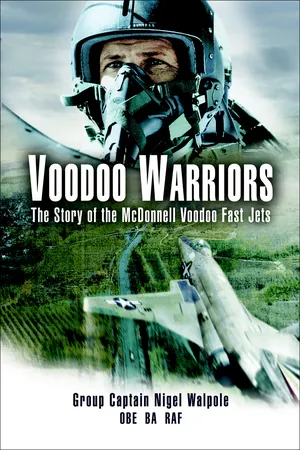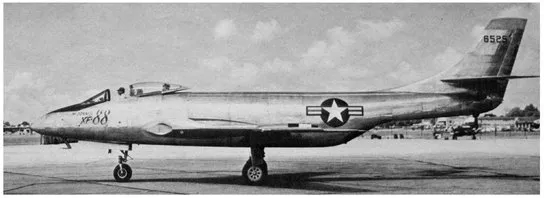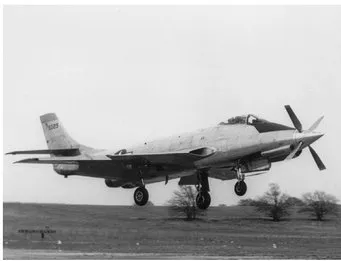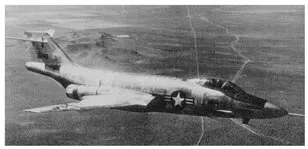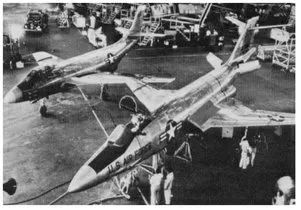![]()
PART ONE: COLD WAR CONTINGENCIES
![]()
CHAPTER ONE:
EVOLUTION
‘Military history is filled with the record of military improvements that have been resisted
by those who would have profited richly from them.’
B H Liddell Hart, 1944
Throughout the latter stages of WW2 the United States Army Air Force (USAAF) wrestled with the problem of replacing its venerable P-47 and P-51 long range escort fighters with aircraft capable of taking on the formidable new German jet fighters, the ME 163 and ME 262, on their terms. These war years bred the vision and imagination needed, and the jet engine added a new dimension.
The USAAF looked at the Bell XP-83 powered by two jet engines, and such innovations as the ConvairXP-81 with its nose-mounted turboprop and a jet engine at the rear, but both projects failed to meet expectations and were rejected. When the war ended, work was already in progress on the Bell P-59 (which turned out to be a disappointment), the Lockheed F/RF-80 (a better aircraft) and the Republic F-84. It was envisaged then that the F-84 would fulfil short term requirements and much of the impetus for developing more ambitious projects was lost.
That said, brave hearts continued to beaver away at new designs nurtured by sporadic official encouragement and a contract for the McDonnell Aircraft Corporation (MDC) of St Louis, Missouri, was received from the USAAF in late 1945 for two XP-85 ‘parasite’ fighters. These would be small, single-seat, gun-armed jet aircraft which could be carried by B-36 heavy bombers, launched against any threat and ‘caught’ by a gantry of hooks and wires when recovering to the mother aircraft. This concept also proved unsatisfactory and the project was terminated in 1948, as were further parasite trials involving F-84s attached to B-29 or B-36 bombers.
However, the USAAF was adding another string to its bow. In August 1945 Air Materiel Command (AMC) issued an Invitation to Bid for a multi-role long-range bomber escort fighter for Strategic Air Command (SAC), which could double as a ground attack aircraft. The original concept envisaged an armed, two-engine, single-seat fighter with a maximum speed of 600 mph, a combat radius (fully loaded) of 900 statute miles and a service ceiling of 40,000 ft. These ideals would change as work progressed and eventually be greatly exceeded.
MDC rose to the occasion with its Model 36C Penetration Fighter Project, which centred on a large and heavy aircraft powered by two Westinghouse axial-flow J34 turbojets, this initiative being rewarded by a Letter of Contract in June 1946. A mock-up was required within two months, with the first of two aircraft (XP-88) to fly in April 1948 without afterburners, the second (XP-88A) with afterburners. Chief Project Engineer, Bud Flesh, and his team were given their head and gained a reputation for ‘boldness with conservatism’ which would serve them well. There emerged a low/mid wing design, with flying surfaces swept back 35 deg, the horizontal stabilizer set low on the fin and two engines housed centrally below a long and spacious fuselage. This aircraft, which could be adapted to several roles, would be renamed XF-88 when the USAF was formed in 1947, the prefix ‘P’ for Pursuit being changed to ‘F’ for Fighter.
MDC’s Chief Test Pilot, Bob Edholm, flew XF-88 (designated 46-525) on its maiden sortie on 20 October 1948, a little later than scheduled but still only 28 months after clearance to proceed. He found the aircraft quite manoeuvrable and easy to fly, some directional oscillations and yaw/roll coupling problems being overcome with dampers and speed brake buffet remedied by reducing the opening span and perforating the surfaces. True to the old adage, it looked right and flew right.
If it Looks Right - It’ll Fly Right. XF-88, 46-525 proved the point. USAF
Edholm soon achieved Mach 1.175 with XF-88 in a dive from 41,000 ft, with no adverse effects in the transonic zone. However, with only 6400 lb of thrust from the two J34 engines the aircraft was badly underpowered and thrust augmentation was clearly required. Afterburners were the preferred solution but, with any extension to the tailpipes limited to 52 inches, to retain the necessary ground clearance, the engine manufacturers were unable or unwilling to meet the need and MDC produced its own afterburners for the XF-88s, well within the limit.
The second test vehicle, XF-88A, given the serial number 46-526, first flew on 26 April 1949, with a variable geometry stabilator (combined stabilizer and elevator) and six 20-mm cannon. In June 1949 it was the first of the two XF-88s to be retrofitted, initially with one and then two afterburners, which provided 34% more static thrust, a 9% increase in speed at sea level (to 700 mph) and a greatly improved rate of climb. Unfortunately, the price was a significant increase in specific fuel consumption and a commensurate reduction in endurance, already one of the critical shortcomings. XF-88A was immediately committed to an intensive test programme at Edwards AFB, which included brief trials in weapons carriage and delivery, and was selected to take part in the Penetration Fighter Project ‘fly-off’ to be held in June and July 1950.
Soon after its arrival at Edwards, 6526 was damaged in a wheels-up landing and had to be replaced by 46-525, hastily re-engined with the afterburning J-34s to become the second XF-88A. The other two contenders in the competition were the Lockheed XF-90 ‘Super Star’ and North American Aviation YF-93A ‘Sabre Cat’. All three aircraft were found to suffer to a greater or lesser extent from similar problems; in particular, they were all underpowered. The YF-93A could achieve a similar top speed to that of the XF-88A (some 708 mph in level flight) with one Pratt and Whitney J48 (derived from the British Rolls Royce Tay engine) which produced 8,750 lb of thrust in afterburner, but it did not have the inherent ‘get you home’ advantage of a second engine. On the other hand, the XF-90, although generating similar thrust from two Westinghouse J34 in afterburners, could only reach some 667 mph. A consensus among the seven pilots involved was that the North American entry was the least attractive option of the three. They were also unhappy with the Lockheed XF-90, despite its great structural strength its performance overall was poor.
Value Added. XF-88A, 46-526, with the MAC afterburners gave more power but not enough. The 20-mm cannon and perforated airbrakes are also evident. USAF
Voodoo Power. The two Pratt and Whitney J-57 engines, each generating 15,000 lb of thrust in afterburner, gave the Voodoo an edge over all its contemporaries, and remained the basic power plant throughout the aircraft’s life. USAF
So it was that MDC’s entry won the day, but even this fell short of the specified requirements and no contract was issued. During the fly-off, anticipated budgetary cut-backs began to bite as funds were diverted to support other air force projects, specifically the B-47 nuclear bomber programme, and this resulted in the cancellation of the Penetration Fighter Project. As a consequence, both 46-525 and 46-526 went into storage but there would be resurrection.
MDC’s foresight in continuing to make design changes and maintain the pressure on AMC to proceed with improved variants of their aircraft eventually paid off. SAC had found the F-84 to be inadequate as a penetration fighter and still wanted the greater capability. Among the options offered by MDC was one equipped with the two very powerful Pratt and Whitney J-57 engines, each generating 10,000 lb of thrust (dry) and 15,000 lb in afterburner, making it very attractive to the USAF. In 1952, funds were made available to MDC to continue its work and the firm received an initial contract for what was now designated F-101, an early member of the ‘century series’, fast-jet club and the heaviest, most powerful single-seat fighter to date. The Voodoo was born.
So the trials resumed, during which 46-525 was withdrawn for NACA (later NASA) to evaluate several supersonic propeller permutations with an Allison turboprop engine added in the nose to create an XF-88B ‘trimotor’. Modifications included the displacement of the nose leg to one side to make room for the turboprop and extending it to give the required propeller clearance; a fuel cell also had to be removed to stow test instrumentation. This aircraft first flew on 14 April 1953 and thereafter with NACA at Langley AFB.
McDonnell’s Hybrid. Voodoo 46-525, fitted with an Allison XT-38 turboprop engine, the trimotor XF-88B, made its first flight at St Louis on 14 April 1953, the nose gear seen here offset to the right to make space for the turboprop engine. Robert F Dorr
First of Many. The first Voodoo F-101A, 53-2418, had its maiden flight from Muroc Dry Lake on 29 September 1954. USAF
The first F-101A Voodoo 53-2418, made its maiden flight at Edwards AFB on 29 September 1954 with Robert Little at the controls. This was a very different aircraft from the XF-88, with a much larger fuselage to accommodate the two Pratt and Whitney J57-P-13 turbojets and the extra fuel necessary. The horizontal stabilizer had been moved to high on the fin, clear of the afterburner plume, and the speed brakes were now hinged forward. Little found everything about the flight ‘spectacular’; he left the T-33 photo plane and F-100 chase aircraft far behind from take-off, climbing to 35,000 ft at Mach .92 in ‘dry’ power and going supersonic in a shallow descent (thought to be a ‘first’ on any initial test flight). Apart from failing to get the nose gear fully retracted quickly enough and suffering some disconcerting engine stalls, all went well, but there would be problems during the subsequent, more demanding trials. On his fourth flight Little had a double flame-out attributed to the failure of one fuel booster pump with the other being incorrectly wired, leaving him only gravity feed to the engine and an exploration of best gliding speed until a relight was achieved and a successful landing completed. It was on his seventh flight that ‘all hell broke loose’, both engines stalling violently at Mach 1.4 as Little tried to find out how fast the aircraft would fly. The problem continued with both throttles returned to idle, the speed brakes being used in earnest for the first time at supersonic speed until the speed reduced to Mach .8, after which the engines behaved normally and allowed another safe landing. In time all the major defects were overcome or minimised by modifying the engines or aircraft; engine stalls much reduced by correcting uneven pressures across the compressor with redesigned engine intakes and adding turning vanes. Other difficulties could be avoided by adhering to prescribed handling procedures.
Size is Everything. This side-by-side comparison with the XF-88 shows the much larger F-101A, 53-2418 needed to accommodate the bigger engines and more fuel. The photo also shows the latter’s high tailplane and forward-hinged airbrakes. USAF
Then there were the undercarriage (landing gear) problems, that of the ‘hanging nose wheel’ avoided by retracting the gear before reaching 250 kts on take-off (sometimes rather easier said than done!). Generally, the main wheels took the heavy aircraft’s high take-off and landing speeds well, but in less than ideal circumstances, particularly with severe side loads, the collapse of one or both main legs was not unusual. Tyre wear was very high. Of greater concern was the legendary pitch-up - a potentially disastrous occurrence. Over simplified, the wing would mask the tailplane from the airflow at high angles of attack, or deflect a down-flow on to the high-set stabilizer, causing a loss of control and nose-up pitching moment, often followed by a spin, from which recovery could be very difficult. At first, the aforementioned engine problems had priority but when these were largely resolved pitch-up ...
